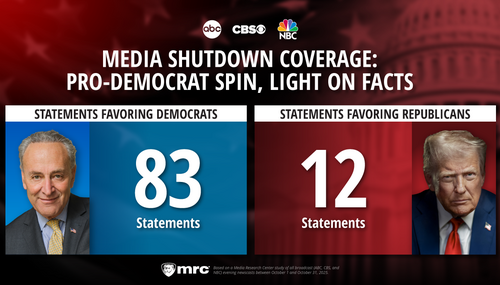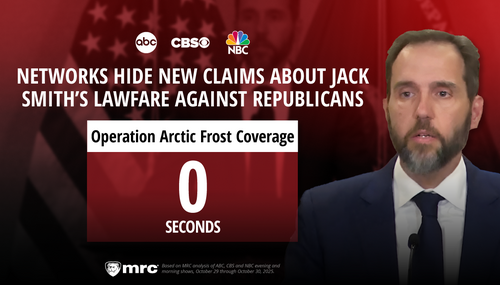Campaign promises are a rite of passage for presidential hopefuls. If you can promise enough people you’ll give them what they want, you just might have a chance at getting elected. But how much do these promises cost and how would we pay for them?
Amid calls for an emergency economic stimulus package, presidential candidates called for cash handouts. But the network news shows by and large ignore many of the policy proposals put out by the campaigns aimed at securing votes and spending taxpayer money. And when they do mention such proposals, very few questions are asked about where the money will come from.
“Well, I think that it’s important for us to make sure that we get as much money as quickly as possible into the pockets of hard-working Americans, understanding that, you know, we have finite resources,” Sen. Barack Obama (D-Ill.) said on the CBS “Early Show” January 27.
Obama’s reference to “finite resources” seems ironic, considering he leads all presidential contenders in proposed new spending with a whopping $287 billion, according to a new report from the National Taxpayers’ Union Foundation.
Fellow Democrat Sen. Hillary Clinton (N.Y.) trails him with $218 billion in proposed new spending. Republican candidates come in much further behind. Former Arkansas Gov. Mike Huckabee has proposed new funding totaling $54 billion. Former Massachusetts Gov. Mitt Romney proposed $19.5 billion and Sen. John McCain (
Few of their proposals have been examined on the broadcast news outlets, however. Only
Other proposals – including several ideas for economic stimulus, Obama’s $10 billion to help Americans who borrowed more than they could afford,
The answer, of course, is: you! The government pays for its programs with taxpayer money, so increased spending must be met with either cuts from other programs or finding ways to increase government revenue, like raising taxes.
But reporters routinely missed opportunities to investigate stimulus proposals. When Obama talked about his plan to “put forward a $10 billion fund to focus on helping families that … have been induced into mortgages that they can’t pay” on ABC’s “This Week” January 27, host George Stephanopoulos didn’t bother to ask Obama how he’d pay for the fund.
When Obama told Harry Smith of the CBS “Early Show” that “it’s important for us to make sure that we get as much money as quickly as possible into the pockets of hard-working Americans” January 27, Smith didn’t probe further to find out how much money Obama was talking about.
Clinton’s $62-billion economic stimulus package – including an emergency housing crisis fund, heating oil subsidies and expansion of unemployment
Can the ‘Bush Tax Cuts’ Pay for Everything?
Of the hundreds of programs promised by the various candidates, only Clinton’s health care plan stood out as worthy of “extensive” media scrutiny. Announced in September,
It would also cost taxpayers $110 billion every year. Clinton made it clear she would help finance her health care plan by “rolling back” the Bush tax cuts, amounting to a massive tax increase. But she had to admit that wouldn’t cover it all. Some journalists took note.
“
“Watchdog groups and legislative sources said it is impossible to know whether the money from the about $55 billion in tax cuts from the wealthiest 2 percent of Americans will be available for a president to spend on other priorities,” Christina Bellantoni wrote in The Washington Times Sept. 20, 2007.
Other questions about
“Your plan costs more than anybody else’s. It runs out at more than $100 billion a year and relies very heavily on rolling back the Bush tax cuts,” Harry Smith said on the September 18 “Early Show. “That’s sacred ground for Republicans.”
“Good Morning
“Mr. Obama this week said getting rid of Mr. Bush’s tax cuts would fund his proposed $85 billion in tax cuts for the middle class. But his $50 billion health care plan is also funded by the Bush tax cuts and cost-savings measures,” Bellantoni wrote.
Anne Kornblut of The Washington Post mentioned Obama’s apparent double-talk in a Sept. 19, 2007, brief, noting his promised tax cuts though “he earlier said he would use those funds for his health-care program.”
Complete Ignorance
The vast majority of the programs in candidates’ platforms seem to have gone unnoticed in the media. Some examples:
-
Obama, whose $287 billion in promises eclipses the other candidates, promoted a ‘Zero to Five’ plan to spend $10 billion every year on expanding Early Head Start and Head Start programs and providing child care for working families, among other initiatives. None of the networks mentioned Obama and the Head Start program or his “Zero to Five” initiative label in the last six months.
Obama has proposed doubling foreign aid to $50 billion over the next five years. Only one story in the last six months has even mentioned Obama and foreign aid at the same time – it was an interview with Republican candidate Rep. Ron Paul (
Romney has proposed spending $200 million over the next five years to increase safety standards on things like imported food and toys. Even with all the coverage of Chinese toys tainted with lead, broadcast TV didn’t mention Romney’s spending proposal.
Romney has also supported spending $5 billion over 10 years to fund stem cell research. Tim Russert asked Romney about stem cell research on “Meet the Press” December 16, but the issue of Romney’s support for funding wasn’t part of the discussion.
NBC’s Ron Allen mentioned on the January 14 “Nightly News” that Romney supported a “huge $20-billion investment in the struggling auto industry,” but failed to question the candidate on where the money would come from. Even when reports mentioned the price tags of some of the proposals, they rarely investigated the source of funding.
Blips on the Radar
Even the few times spending proposals were covered they received little, if any, follow-up.
The networks have mentioned “
A November 30 CBS “Early Show” segment referenced Clinton’s support for $50 billion in AIDS relief without mentioning how she might pay for it.
Bob Schieffer, host of CBS’s “Face the Nation,” on January 27 asked Giuliani how much a catastrophic insurance fund would cost.
Even the candidates themselves have noticed the media’s failure in reporting on the exorbitant costs of their opponents’ promises, as well as the candidates’ failure at explaining where the money will come from.
“Senator Obama puts out a lot of his policies without paying for them, about 50 billion, as we have calculated,”
But at least one print journalist agreed – The Washington Post’s media columnist, Howard Kurtz. Explaining how journalists haven’t really gotten to Obama, Kurtz noted one of the candidate’s speeches was “saturated with proposals.”
“There was no discussion of how he would pay for all this, other than to say his health-care plan would be partly financed by ending the Bush tax cuts for the wealthiest 1 percent of Americans,” Kurtz wrote January 28.
“Back in November and December the print media was doing a fairly decent job of analyzing the proposals of the candidates,” NTUF Senior Policy Analyst Demian Brady told the Business & Media Institute, “but once January hit and voters started actually going to the polls and speaking, out the horserace coverage has dominated the reporting of the race."
But Brady said he was hopeful that the reports from NTUF would be “a good reminder to the media and the voters” of the promises candidates are making and the costs associated with their proposals.





